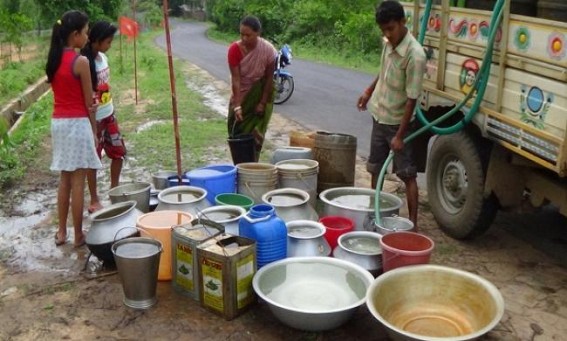TIWN

KHOWAI/AGARTALA, May 3 (TIWN): In the so called ‘Golden Era’, the residents of Padmabill block, Sukaribari, Baijalbari zonal office area, Aampura, Ratanpur, Kangabari and other 32 villages under Khowai district are facing from acute drinking water scarcity for the last three years.
According to sources, several times the residents of the villages approached to the Drinking, Water and Sanitation (DWS) officials regarding the issue. But the DWS officials also avoided the issue. Only five water tankers are providing water in the said villages, which is not sufficient for the villagers, said sources.
The latest statistics shows, as many as 330 habitations of Tripura are still uncovered for purified potable water sources. Obviously, these locations are always prone to the spread of water-borne of diseases and ever year at least two outbreaks of seasonal gastro infections – pre monsoon and post monsoon are reported over the decades.
Although the administration has taken steps to contain the intensity of the diseases by introducing mobile health check up vans in vulnerable location and supply of water by tankers; yet safe and good health care facilities are still absent in more than 1276 distant locations of Tripura. Technical report of Drinking Water and Sanitation, Government of Tripura contemplated that ground water table in more than 60 percent of the uncovered locations are below traceable limit because of physiographical structure where only sustainable supply of water will be piped line that to also very expensive.
Annual average per capita water availability in Tripura is assumed is 35000 liters against national availability of 18000 liters but uneven distribution of water among the citizens and distribution loss resulted crisis during dry spell and flash flood in low-lying catchments of rivers in monsoon. Traditionally, hill living people are not acquainted with smart changing life-style and habits that also emerged sometimes challenging to ensure them piped water.
Altogether 2931 habitations of Tripura are identified having excess of fluoride, Nitrate, Iron and Arsenic in the report of Northeastern Regional Institute of Water and Land Management (NERIWLM). Tripura has recorded second quality affected water sources in the region with 28181 habitations. The water sources gradually getting dry or lowering of the ground water table besides, systems working below rated capacity due to poor operation and maintenance increase in population resulting in lower per capita availability and slippage have also taken place due to seasonal shortage of water. NERIWLM attributed a multi-prong strategy to tackle the water quality problems has been evolved and for Nitrate preventive measures like reduction in the use of chemical fertilizers and controlling leaching of sewage pollution coupled with surface water harvesting techniques have to be adopted.



